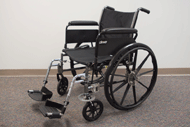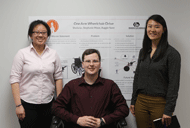Allez: A Modular One Arm Wheelchair Drive Attachment for Persons with Hemiplegia
Sheila Lo, Stephanie Moon*, Auggie Nanz
Abstract


Problem Statement
Each year, 800,000 people in the United States have strokes. As a result, there are 6.3 million people in the US that have ever had a stroke; it is the leading cause of long-term disability and third leading cause of death.3, Of people who have strokes, hemiplegia, or hemiparesis, is a common outcome, leaving individuals with weakness of one entire side of the body.1,2 This loss of functionality can also be caused by other various medical conditions such as trauma, tumors, and congenital causes, but is very commonly caused by strokes.
As with other serious medical conditions, strokes result in a change in lifestyle for both the recovering individuals and their caregivers. Specially engineered devices aim to support rehabilitation and promote individuals’ independence. However, people with hemiplegia currently do not have a cheap and effective way of independently moving themselves around. Our product aims to provide a solution.
Research Question and Background
Research in the current market showed that the most common solutions that promote independence in mobility include power wheelchairs and one arm drive attachments. However, powered wheelchairs are expensive, require drastic changes in living style, and prevent users from actively exercising their “good” side. On the other hand, one arm drive attachments to manual wheelchairs are expensive and require significant muscle coordination or awkward movements in order to propel and steer the wheelchair, leading to fatigue, as confirmed through speaking with several rehabilitation engineers and physical therapists.
Because current one arm devices for wheelchairs do not provide affordable and efficient solutions that give people with hemiplegia greater independence, there is a need in the market for a one arm drive attachment. In our design, we aim to address these shortcomings and provide a robust solution to fulfill this need. Thus, our goal is to allow people with hemiplegia to move with ease by producing an affordable and durable one arm wheelchair drive attachment capable of being adapted to various manual wheelchairs.
Methods/Approach/Solutions Considered
We explored several ways of producing an add-on kit for manual wheelchairs to allow them to be driven using only one arm and one leg. Based on the work by a Caltech group last year that directly coupled the main wheels using a shaft , we investigated ways of improving this design. Last year’s design allowed the main wheels to either move together at the same rotational speed or rotate opposite each other. This meant the chair could move in a straight line or rotate in place, but it would not allow it to smoothly and continuously change directions.
To improve upon this design, we considered replacing the shaft between the wheels with a differential. The differential would allow the wheels to turn at different rates. Then the power provided on one wheel would be distributed to both wheels and allow the chair to make as gradual/tight of a turn as the user desired. Meanwhile, the user would be able to control the turning of the wheelchair through a foot pedal directly attached to a caster wheel.
After consultation with a UK company called Neater Solutions, we determined that the differential shaft linking the main wheels may not be necessary; we only need to implement a steering system for a manual wheelchair to be useful for a person propelling with one arm. To test the feasibility of this method, we constructed a prototype. From this foot pedal attached to the caster fork, we realized that the wheelchair is quite maneuverable without the added weight and cost of a shaft linking the main wheels.
Description of Final Approach and Design
Our latest prototype is composed of a thumb joystick, an actuator coupled to a caster wheel, and an Arduino that sends the signals from the joystick to the actuator. After multiple prototyping iterations, we decided on an electromechanical approach. The advantages of an electronic device over a purely mechanical one include being able to easily customize the actuator’s response to the individual user; we can de-bias their input and adapt the system to their range of motion. In addition, we have more design flexibility because there are fewer mechanical constraints with the wheelchair. This also means that an electrical device would be more compatible with different types of manual wheelchairs. A mechanical system has the advantage of not requiring a battery that adds weight and needs to be charged, as well as being easier to fix if broken. However, we believe the advantages of an electrical device outweigh those of a mechanical device.
An RC servo motor with built-in position control was chosen for the current design. It directly drives a primary spur gear of 2 in diameter which then drives the secondary gear of 5 in diameter, thereby providing a gear ratio of 2.5. The secondary gear was cut to be compatible with the caster fork while also minimizing weight. The servo motor and gears allow the caster wheel to turn 72 degrees. The gears were fabricated by water jetting 0.25 in thick aluminum and were attached to the caster stem via a custom connector. A key prevents the secondary gear from rotating axially on the connector and a shaft collar is mounted underneath the gear to constrain the gear’s movement along the axis of the connector. A motor mount and two clamps were also designed to place the motor in a location tucked underneath the wheelchair. An Arduino is used to communicate between the servo motor and a thumb joystick. The servo motor is powered by a 6.6 V battery. The assembly was arbitrarily mounted on the left caster wheel.
We are continuing to improve upon our current design. Our final design will use a more robust motor that allows the caster wheel to turn at least 180 degrees for a full range of motion and supports the full required torque. In addition, we plan on implementing a modular foot pedal input that sends the rotational movement of the pedal as a signal to command the caster driving motor. The foot pedal would be easily mountable to the wheelchair footplates (i.e. using DualLock or Velcro). A rechargeable 2 cell Lithium Polymer battery with nominal voltage of 7.4V that lasts at least 12 hours will be used. A lightweight plastic covering will also be placed around the gears and motor for safety and weather protection.
Outcome
The latest prototype functions as designed without any unforeseen problems. It lets the wheelchair turn 35 degrees to the left and 35 degrees to the right. The wheelchair can also be pushed by a caregiver with the device installed.
We visited Rancho Los Amigos Rehabilitation Center to interview a patient with hemiplegia who suffered from a stroke three months prior. He plans on regaining his strength through rehabilitation- thereby being a short term wheelchair user- so he would be an ideal consumer of our product. He currently uses his good foot against the ground to steer and propel. When presented with the concept and design of our device, he was enthusiastic and said he would use the product for mobility. We also learned that many manual wheelchair users including our interviewee propel themselves backwards, especially when going up ramps. Thus, we will make sure our device is capable of accommodating robust forward and backward movement. In addition, the foot pedal should be quickly stowable and the device should be out of the way for cases the user wants to use his strong foot against the ground.
We also received positive feedback from physical therapists and other employees of Rancho about the direction of our project. They thought the device was simple, intuitive, and addressed the need of a one arm wheelchair device. One highlighted the importance of keeping the device lightweight. An important feedback we received was that the joystick may not be of significant use because by the time the user can control the joystick, he may not need the device at all. This is because people start regaining their strengths from their legs and the joystick needs fine hand control that comes in the latter stage of rehabilitation. Thus, our team plans on conducting further research and talking to more physical therapists to decide the necessity of the joystick. We also plan on presenting our later prototypes to people with hemiplegia to gain feedback.
Cost
Our goal is to make our product realistically available as an option for individuals in mid to lower socioeconomic situations. We currently estimate the final cost of our attachments to be around $265; this includes the material cost for the gears, gear safety cover, motor, motor mount, foot actuator mechanism, and joystick as well as the labor costs to manufacture the device. The cost of our product should decrease significantly if we purchase our materials in bulk or form partnerships with suppliers. Labor costs will also be brought down as a result because all of our part manufacturing can be mechanized. Our estimated materials cost for manufacturing a single one arm wheelchair drive attachment kit is $190. We believe this is an upper bound on material cost and have overestimated where costs are uncertain.
Significance
Currently, there is no intuitive, affordable, and effective one arm drive system on the market. As a result, manual wheelchair users with hemiplegia often use their foot to propel and steer, which can be very strenuous and uncomfortable. Our affordable device provides a solution for these users of mid to lower socioeconomic status in the US. In the long run, our product could reach users from around the world.
Through our design, we want to provide people with hemiplegia a means of independent mobility and possibly help them in their rehabilitation process by allowing them to use their strong foot and arm while giving them the option of regaining purposeful movement in their weak arm through the use of a joystick.
Future work includes increased patient and therapist involvement in later iterations, researching joysticks to find one that is intuitive to use and provides for sufficient sensitivity in response to motion, and improving the safety and aesthetics of our overall design.
References
http://aac-rerc.psu.edu/wordpressmu/RESNA-SDC/2015/04/18/one-arm-drive-wheelchair-attachment-caltech/
http://www.cdc.gov/stroke/facts.htm
http://www.ninds.nih.gov/disorders/stroke/stroke_rehabilitation.htm
http://www.strokecenter.org/patients/about-stroke/stroke-statistics/
http://www.cdc.gov/nchs/fastats/stroke.htm
http://www.disabled-world.com/health/neurology/hemiparesis.php
http://aac-rerc.psu.edu/wordpressmu/RESNA-SDC/2015/04/18/one-arm-drive-wheelchair-attachment-caltech/Acknowledgements
We would like to express our thanks to our project advisers at Caltech and Rancho Los Amigos National Rehabilitation Center. From Caltech, we are grateful for the engineering expertise provided by Professor Kenneth Pickar, Tatiana Roy, and John and Amanda Van Deusen. Andy Lin, MS, ATP and Phil Requejo, Ph.D. who are both rehabilitation engineers at Rancho provided valuable perspectives on assistive technologies. Carrie Nofzinger, PT and her patient from Rancho gave us detailed insight on designing for people with hemiplegia. Finally, we are thankful for all of the guest speakers in E/ME/MedE 105: Design for Freedom from Disability, the class from which this project started.